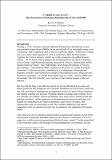A "global nervous system": The rise and rise of European humanitarian NGOs
Date
2014Author
O'Sullivan, Kevin
Metadata
Show full item recordUsage
This item's downloads: 971 (view details)
Recommended Citation
Kevin O'Sullivan (2014) 'A global nervous system: The rise and rise of European humanitarian NGOs' In: Marc Frey, Soenke Kunkel and Corinna Unger(Eds.). International organizations and development, 1945-1990. Basingstoke : Palgrave Macmillan.
Published Version
Abstract
Going a step beyond the guiding principle
of Amnesty International and the human rights movement that individuals
could change the policies of foreign governments humanitarian NGOs emphasised
the power of people-to-people interaction. In the process they contributed to a re-alignment of international relations,
towards a more globalised concept of international action. Their activities
became so prominent or at least their brands were so visible that the 1980s
won the moniker the NGO decade , in recognition of their lasting impact on the
aid industry.
But why did the forty years after the end
of the Second World War provide such fertile ground for the emergence of a
European humanitarian NGO sector? And what role did states play in shaping
non-governmental action? To answer these questions, this chapter combines an
analysis of global currents of change with evidence from two national case
studies: Britain and Ireland. It argues that the role of states and inter-governmental organisations in shaping the fortunes of NGOs implies that the emergence of the international humanitarian sector was not the simple, organic, bottom-up, process that is sometimes described. Instead, those who set the international agenda also largely dictated its terms of engagement. Only
by appreciating the enduring importance of the state can we begin to unpack the
complex relationships that emerged between actors at all levels of the
international system in the second half of the twentieth century.


